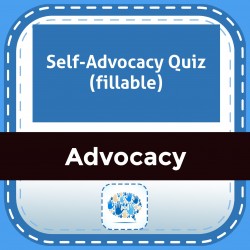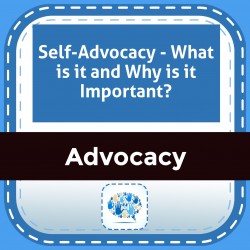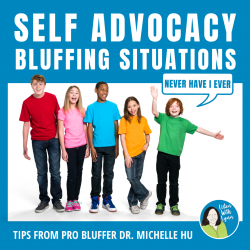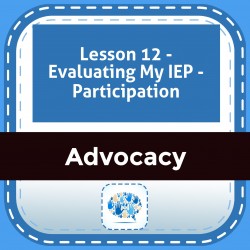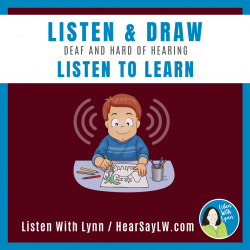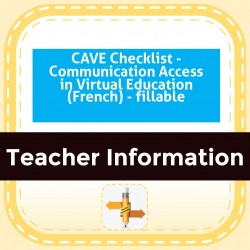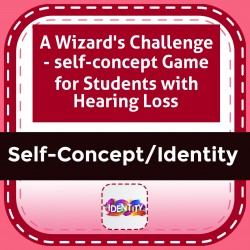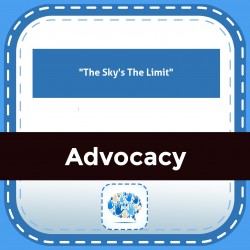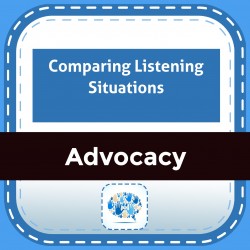Ability Levels
Categories
Resource Types
Age/Grade Range
CCSS
Anchor Standard
Speaking & Listening
Language
Reading
Self-Advocacy Quiz (fillable)
$ 250
True/False Quiz with 4 situational word problems. Students must read situations and respond whether it reflects appropriate student rights, especially with hearing tECH-nology.
Self-Advocacy - What is it and Why is it Important?
$ 250
Worksheet seeks answers showing a student's knowledge of what self-advocacy is, and rating actions demonstrating self-advocacy strategy use.
Self-Advocacy Bluffing Situations - Never Have I Ever Activity
$ 7
18 Mini-Lessons target BLUFFING and foster self-advocacy and personal responsibility for kids that are deaf and hard of hearing. This resource is based on the NEVER HAVE I EVER game which is fun and m
...
and motivating for elementary and middle school-aged kids.Bluffing is pretending to hear or acting in a way that shows you understand what is being said when you are not following the conversation. Bluffing, faking, and pretending are common habits of most people with hearing loss.INCLUDED:Tips from Pro-Bluffer, Dr. Michelle Hu, a pediatric audiologist and bilateral cochlear implant recipient. Michelle knows what it is like to bluff and shares words of wisdom based on her life experiences. Follow Michelle on Instagram as she shares her hearing loss journey.18 Never Have I Ever Mini-Lessons✧ Real photos that illustrate the social situations and scenarios✧ Each situation pictures a student who says: (example) "Never Have I Ever pretended that I didn’t want to join in the game.”✧ The kids' self-talk or comments. (example) "It’s easier to not play rather than mishear and mess up."✧ Talking points with guided questions/discussion prompts.Children grapple with BLUFFING in challenging situations. Discussing possible plans of action, and exploring positive coping and communication repair strategies within a supported environment is important. Self-advocacy success requires knowledge, skills, and importantly ample practice opportunities.➼ DIGITAL - NO PRINT can be opened and played with your favorite PDF reader app on a tablet. When playing on a computer, open and use a PDF reader such as Adobe Acrobat Reader DC which is free. ➼ PRINT - Print out the 18 situations and a copy of the Discussion prompts and questions.◈ ◈ ◈ ◈ ◈ ◈ ◈ ◈ ◈ ◈ ◈ ◈ ◈ ◈ ◈ ◈ ◈ ◈ ◈ ◈ ◈ ◈ ◈ ◈ ◈ ◈ ◈ ◈ ◈ ◈ CUSTOMER TIPS➼ Questions? EMAIL ME before purchasing this resource or anytime later.♥ Sign-up HERE for the Listen With Lynn Emails♥ Let’s ConnectInstagramFacebookKeep up your good work. I am blessed to help along the way.Thanks so much!Lynn Wood
Lesson 12 - Evaluating My IEP - Participation
$ 0
Lesson 12 - Evaluating My IEP Participation. This lesson leads students through a process of self-evaluation regarding their participation in their IEP meeting. By Kris English.
Advocacy - Steps to SA Success Goal 2- Use of Technology
$ 195
Students learn vocabulary associated with hearing technology and how to take care of it. Use this fillable worksheet with students to problem-solve what is good/bad for devices.
Self-Advocacy Listen & Draw Directions DHH
$ 3
LISTEN TO LEARN is the eighth in the popular Listen & Draw series. These are all auditory imagery activities that target following directions while growing vocabulary, memory and sequencing skills. De
...
etails can be easily simplified or information added to increase the complexity to match the child’s listening and language goals.Children listen to detailed descriptions then follow the directions and draw four different young students all of which are deaf or hard of hearing and use hearing technology. A couple of the kids could be better listeners which is both entertaining and learning opportunities for the kids.Isabella hears with two cochlear implants.Watson hears with two hearing aids.Bryn hears with a Baha® device.Noah hears with a hearing aid in his left ear and a cochlear implant on the right. This LISTEN TO LEARN activity also targets self-advocacy skills. Talking through each scenario will encourage your students to understand the importance of listening to learn and be successful at school.Listening and Spoken Language (LSL) tips are included to encourage auditory learning.
CAVE Checklist - Communication Access in Virtual Education (French) - fillable
$ 0
The CAVE Checklist in French is a self-report checklist is intended to be completed students age 9 and above who are deaf or hard of hearing to identify possible communication access issues that may o
...
ccur during virtual education situations. It is recommended that the CAVE be completed in an interview format with the DHH specialist discussing each situation with the student. Students read 10 questions related to accessing communication in online learning situations and rate them from Always Easy to Always Difficult, or Doesn't Happen. A total score can be obtained. Not every situation will apply to every student. Situations indicating appropriate access will receive scores of 4 or 5. Items scoring 1, 2, 3, need to be addressed for appropriate access needs. The 10 questions are followed by a list in which the student identifies what he or she thinks helps most during online learning.
A Wizard's Challenge - Self-Concept Game for Students with Hearing Loss
$ 0
The Wizard's Challenge Game is a relevant and motivating resource which can be effectively used with students to reinforce standards based IEP goals and/or objectives in the areas of self-advocacy, se
...
lf-concept, communication repair and amplification utilization. The game relies on the players having some knowledge of the Harry Potter books or movies as it compares children with hearing loss living in families where they are the only ones who are deaf or hard of hearing to families of muggles that have a child who is a wizard or witch born into them. A parallel is drawn of Harry as 'The Boy Who Lived' being the only one with a lightening bolt scar on his face at Hogwarts to the student who is the only one using hearing devices in his or her neighborhood school. Print your own game board, cards, and game pieces.
"The Sky's The Limit"
$ 299
A collection of comic strips revealing troublesome situations for teens with hearing loss. Includes commentary on how each humorous situation might be resolved.
...
Comparing Listening Situations
$ 5
This interactive Google Slides activity asks students to evaluate 4 listening situations (presented in pictures and short descriptions) and rate them on a scale according to listening difficulty. Afte
...
r rating the situations, students are tasked with providing an explanation of why each situation is difficult or easy to hear. This would be a great 'stepping off' activity to begin a unit on coping skills or to evaluate how a student perceives different situations and why/how he/she feels about his/her listening abilities.There is very little digital learning activities available for remote learning today. This tool that asks students to rate situations that are difficult or easy to hear encourages introspection about a student's hearing loss. Asking student to explain why the situation is easy or hard to hear encourages them to evaluate their own listening skills and how advocacy can improve even the most difficult situation.Learning Objective:The student will be able to compare listening situations by rating them on a scale from easy to hear to hear. The student will be able to describe why a specific listening situation is difficult or easy to hear, giving support for their answers.
 Your browser is out of date. For best experience switch to latest updated Browser.
Your browser is out of date. For best experience switch to latest updated Browser.
 Get Chrome
Get Chrome Get Edge
Get Edge Get Firefox
Get Firefox